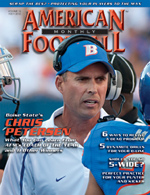Article CategoriesAFM Magazine
|
Max Protect: Base Layer Protective Apparel Helps Make the Game Fasterby: Jim DouvilleAssistant Coach, Newman Catholic High School, Wausau (WI) © More from this issue As coaches we have seen the meteoric rise of the spread offense and the emphasis on speed in recent years. Now we’re seeing equipment – particularly protective gear – designed to be more lightweight, streamlined, and targeted to meet the demands of today’s faster players and schemes on both sides of the ball. With tenths of a second being the difference between winning and losing, every ounce of equipment matters. Players and coaches are searching every avenue possible to garner the most speed they can to be successful on the field. And athletic equipment vendors are attempting to address this demand with lightweight base-layer protective apparel. These pads are targeted primarily toward skill position players, linebackers and defensive backs. They take the place of traditional hip, thigh, tailbone and – in some cases – rib pads. The speed game demands lighter weight, but the size of today’s players also translates to more impactful hits. This gear attempts to address both issues at once. McDavid, the first manufacturer to offer this type of protective gear, offers a line of Hexpad shirts, shorts, and sleeves. The Hexpad technology uses compression-fit garments to keep major muscles groups warm, decrease unnecessary motion and vibration while helping to reduce muscle fatigue by increasing blood circulation. (All base layer protective apparel have some version of padding in compression-fit garments to keep muscles warm and limber and to offer some level of stability and efficiency). McDavid also uses a construction process, HydraVent hDc, that features a polyester fabric combined with compression-fit material to remove sweat and moisture away from the body and into the fabric where it’s quickly evaporated, helping the athlete stay cool and dry. Old cotton shirts and shorts don’t rapidly allow for evaporation, so years ago an athlete had to carry this “water weight” during any workout or competition. The advancement of technologies such as HydraVent hDc wick away the moisture, allowing players to carry less weight and move more comfortably. McDavid attaches an encased layer of padding on the exterior of the Hexpad shirt or shorts in high impact locations – ribs, thighs, shoulders, tailbone, and hips. The padded areas are comprised of numerous padded hexagons, and the design allows the pad to move through every range of motion – a huge advantage over less flexible and cumbersome traditional static pads. With a variety of different pad depths and widths, athletes can find just about any level and coverage area of protection. Stromgren Athletics addresses the need for lightweight protection with the new model 1575 5-Pad Football Compression Girdle. This padded girdle provides the protection and compression features that Stromgren has always given the football athlete, but with a new look and design. The new hip pad design protects the iliac crest with high compression foam. Made with anti-microbial fabric, the 1575 is perforated to wick perspiration away from the body and it washes and dries better than previous models. According to Stromgren, scientific research has proven the FlexPad compression system can help reduce muscle vibration, which will help reduce muscle fatigue and help an athlete play longer at their highest level. Zoombang offers athletes the same types of protective compression-fit shorts and tops, but the technology is much different. Zoombang encapsulates a gel-like polymer in strategically placed cells on its clothing. These cells are soft and pliable to the touch, but when blunt force is applied, the polymer stiffens instantly. Then, once the impact force has been absorbed and dispersed, the cells return to their soft, pliable form. Unlike foam padding, which deflects some of the direct force, the Zoombang gear can handle almost all of the blow. The one drawback so far is that Zoombang apparel carries a general heavier overall weight than protective gear offered by other vendors because of the gel-filled cells. However, Zoombang has taken the stand that its padding is less bulky than other versions and can offer an athlete more range of motion. So it appears to be a tradeoff. Similar to the McDavid Hexpad, Nike’s recent line of Pro Combat protective apparel features Nike Pro compression fit construction on shirts, shorts and sleeves to wick moisture away from the athlete’s body while offering zones of padding in key areas. The difference in the Nike Pro Combat gear – according to Nike – is the shape of its padding (ovals) and the way they’re placed together offers better coverage during the moment of impact. They also will not split away from each other as the shirt or short flexes. Another area of difference in Nike Pro Combat is an accessory designed specifically for football on the thigh pad area. Nike Pro Combat offers a hard plastic shield that attaches to the grid of ovals to provide an even stronger layer of coverage. Recently, Nike has introduced their Pro Combat for the basketball court as well, using the same design as the football version. When speed is the x-factor and the teams that have it are increasingly more successful, coaches and players rely on this type of padding to gain an edge or level the playing field. Compression-fit garments that wick away water weight combined with padding that allows an athlete to move freely while maintaining the same or even better protection to the bulky thigh, tailbone and hip pads of the past help athletes and coaches save those precious ounces that could make a difference on the field. p Jim Douville, a copywriter for Eastbay/Footlocker.com, has been an assistant football coach at Newman Catholic High School in Wausau, Wisconsin, for five years. He was also an assistant coach at the University of Wisconsin-Stevens Point for one year. |
|
| HOME |
MAGAZINE |
SUBSCRIBE | ONLINE COLUMNISTS | COACHING VIDEOS |
Copyright 2024, AmericanFootballMonthly.com
All Rights Reserved




